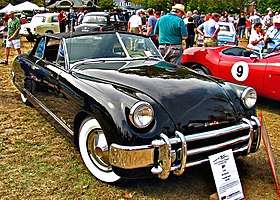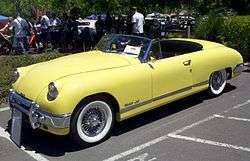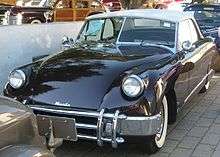Muntz Jet
| Muntz Jet | |
|---|---|
 1951 Muntz Jet at the Dayton Concours d'Elegance | |
| Overview | |
| Manufacturer | Muntz Car Company |
| Production | c. 1949–1954 |
| Assembly |
Glendale, California Evanston, Illinois Chicago, Illinois, United States |
| Designer |
Frank Kurtis Sam Hanks |
| Body and chassis | |
| Class | Personal luxury car |
| Body style | Hardtop convertible |
| Powertrain | |
| Transmission |
General Motors Hydramatic Three-speed Borg-Warner manual transmission |
| Propulsion |
160 hp (120 kW) Cadillac V8 160 hp (120 kW) Lincoln V8 |
| Dimensions | |
| Wheelbase | 2,870 mm (113 in) |
| Height | 1,372 mm (54 in) |
| Curb weight | 1,814 kg (4,000 lb) |
| Chronology | |
| Predecessor | Kurtis Sports Car |
The Muntz Jet is a two-door hardtop convertible built by the Muntz Car Company in the United States between approximately 1949 and 1954. It is sometimes credited as the first personal luxury car. Developed from the Kurtis Sport Car (KSC) that was designed by Frank Kurtis, it was produced and marketed by Earl "Madman" Muntz. The car was powered by one of two V8 engines, a 160 hp (120 kW) Cadillac engine or a 160 hp (120 kW) Lincoln motor, and was equipped with either a General Motors Hydramatic transmission or a three-speed Borg-Warner manual transmission. The Jet was streamlined, featured numerous luxury appointments, and was equipped with safety features that were not standard on most cars of its day, including seat belts and a padded dashboard.
Production of the car occurred in Glendale, California; Evanston, Illinois; and Chicago before ceasing in 1954. The car sold for $5,500 in 1953 (about $51,500 in 2017), but cost $6,500 to produce. In total, Muntz lost approximately $400,000 on the venture. Only 198 Jets were built, an estimated 50 to 130 of which are believed to still be in existence. By 2016, fully restored cars had sold for over $100,000 at auction. Author Matt Stone called the Jet "one of the fastest and best-performing American cars of the time" while "Madman" Muntz claimed that the 1958 Ford Thunderbird was inspired by his Jet.
Background
The Muntz Jet was built by the Muntz Car Company, which was founded by Elgin, Illinois, native Earl "Madman" Muntz.[1][2][3] Muntz, who was born in 1914 and attended Elgin High School for three semesters before dropping out,[4] had established a prominent reputation selling television sets, car stereos, and other commercial and consumer electronics.[5][6][7] Before founding the Muntz Car Company, "Madman" Muntz had worked successfully as a used-car salesman and at Kaiser-Frazer dealerships in both Los Angeles and New York City,[4][5][8] even earning the sobriquet of "world's largest car dealer".[9] According to automotive journalist Turk Smith, he "made and lost several fortunes" during his lifetime,[10] and he was married to seven different women.[3][8]
According to an uncredited 1969 article that appeared in the St. Louis Post-Dispatch, Muntz was inspired by the Jaguar XK120 when he conceived of the Jet; his car ultimately achieved faster acceleration than the Jaguar.[11]
Design

The Muntz Jet was developed from the Kurtis Sport Car (KSC), a two-seat, aluminum-body sports car designed by Frank Kurtis.[6][7][12] Muntz bought the rights to the KSC, along with its parts and tooling, from Kurtis Kraft for $200,000.[9][11][12] Sam Hanks, who would later win the 1957 Indianapolis 500, contributed to the redesign and re-engineering necessary to create the Muntz.[7] Like its predecessor, the Jet was also a two-door convertible,[2] although it was built with a solid hardtop.[9][13][14] Two different V8 engines were used in the Jet: a 160 hp (120 kW) Cadillac engine, and a 160 hp (120 kW) Lincoln motor.[11][13][15] The first Jets to be constructed, in Glendale, California, had the Cadillac engine and aluminum bodies, while those built later in Illinois instead had the Lincoln engine and steel bodies.[16][17][18] The cars were equipped with General Motors Hydramatic transmissions;[5][15][19] a three-speed Borg-Warner manual transmission was also available as an option.[1]
Compared to its Kurtis predecessor, the Jet was heavier but also more agile and capable of a higher top speed, due to its lower drive ratio;[4] the Muntz was 400 pounds (180 kg) heavier than the KSC,[13] weighing almost 4,000 pounds (1,800 kg).[20] Its wheelbase was 113 inches (290 cm),[2][19] 10 inches (25 cm) longer in both overall length and wheelbase than the Kurtis,[1][4] which gave it enough room to include a back seat and accommodate four occupants.[7][12][13] The Jet stood 54 inches (140 cm) in height.[19] It also featured body-on-chassis construction, independent front suspension (A-arms with coil springs) and a live rear axle with leaf springs, power steering, four wheel hydraulic brakes, dual exhausts, and a dual coil ignition.[9]
In April 1951, Norman Nicholson described the Jet as having "the appearance of a streamlined, scaled-down limousine";[19] it was available in colors such as boy blue and elephant pink.[11] Similar in appearance to the KSC, the Muntz was more luxuriously appointed than its sports car predecessor.[13][21] Some of these appointments included an all-leather "tuck-and-roll" interior,[7] racing-style Stewart-Warner gauges,[22] and a center console with a Muntz radio.[9] A liquor cabinet and ice chest placed under the rear seat armrests was available as an option.[4] The Jet was equipped with safety features that were not standard on most cars of its day, including seat belts and a padded dashboard.[4][13]
Production and sale

The first 26 to 40 Muntz Jets were built in Glendale, California;[4][11][17] production was then moved to a factory at 1000 Grey Avenue in Evanston, Illinois, where the car was built roughly between 1949 and 1952.[1][17][23] The near cross-country move was necessitated by difficulties related to materials and transportation that plagued the original plant in Glendale.[1] In April 1951, the Muntz Car Company was employing 40 people in its Evanston factory and producing a car a day.[19] The company moved plants once more, and the car was built at 2901 North Sheffield Avenue in Chicago's Lakeview neighborhood beginning approximately in 1952.[1][2][17] Production ceased in 1954.[1][9]
In January 1951, the projected cost of a Jet was $5,000.[15] That year, "Madman" Muntz planned to sell the car out of factory-run showrooms in Houston, Los Angeles, and New York City.[19] With no network of dealers, Muntz Jets were sold to customers directly from the factory.[1] The car sold for $5,500 in 1953, about $51,500 in 2017;[5][14][22] at the same time, a contemporary Cadillac convertible sold for $3,987,[8] and a comparable Lincoln for $3,600.[1] The Jet cost roughly $6,500 to produce,[17] $1,000 more than its sticker price.[14][20][24] Muntz himself estimated that labor costs alone for each Jet produced totaled $2,000.[13] In total, he lost approximately $400,000 on the venture, and after four years gave up on it.[14][17]
Six Jets were fitted with a factory-installed "hop up" kit that included an Edelbrock aluminum intake and twin double-barreled Stromberg carburetors.[5] Muntz Car Company welding chief Peter Condos claimed that two Jets were built with 331-cubic-inch (5,420 cc) Chrysler FirePower V8 engines.[1]
Famous owners of the Jet included Clara Bow, Vic Damone, Grace Kelly, Alfred "Lash" LaRue, and Mickey Rooney.[13][16][22]
Performance
Writing in 1951, Norman Nicholson noted a production Muntz Jet had a claimed top speed of 112 mph (180 km/h); Muntz claimed it could accelerate from 0 to 80 mph (130 km/h) in nine seconds.[19] An uncredited Reno Gazette-Journal news brief from 1956 claimed that the Jet had set a "sports car speed record" of 142 mph (229 km/h).[25] Northwest Herald journalist Mitch Frumkin noted in 2002 that contemporary sources credited the car as capable of achieving 140 mph (230 km/h).[1] "Madman" Muntz claimed that the Jet could reach 150 mph (240 km/h), but automotive journalist Turk Smith, writing in 1969, expressed doubt that it could even attain 130 mph (210 km/h).[10]
Legacy

In total, it is believed that 198 Muntz Jets were built;[5][9][26] earlier estimates of 400 cars produced, a figure possibly sourced to Muntz himself, are now believed to be inaccurate.[5][14][21] An estimated 50 to 130 of these cars are believed to still be in existence.[5][17][21] There is no owner's club for the car, although a registry of owners exists, which has accounted for about 125 cars by serial number.[5] Three Jets are owned by the Petersen Automotive Museum in Los Angeles.[7] By 2002, well restored Jets were selling at auction for $50,000 to $70,000.[1] By 2016, fully restored cars had sold for over $100,000 at auction.[17]
In the assessment of Autoweek writer Graham Kozak, while the Jet "lacks the cachet of the Tucker...it stands on its own as a well-conceived, well-executed luxury convertible".[21] According to author Matt Stone, the Muntz was "one of the fastest and best-performing American cars of the time".[22] Turk Smith, writing in 1969, opined that a well tuned Jet "will still outperform most stock cars of today".[10] In 1969, "Madman" Muntz claimed that the 1958 Ford Thunderbird was inspired by the Jet, and quipped that "I was eight years ahead of my time" with his car.[11]
Thomas E. Bonsall credits the Jet as being the first personal luxury car.[27] In 2000, Daily Herald journalist Jerry Turnquist called it "America's first, high performance, four-seat sports car".[4] It is also considered to be an orphan car.[28]
After production of the Jet ended in 1954, "Madman" Muntz invented and manufactured the 4-track Stereo-Pak tape player, the predecessor of the 8-track tape player.[8][9][24]
In June 2000, Muntz's childhood home of Elgin celebrated the 50th anniversary of the Muntz Jet with a parade featuring numerous Jets and their owners.[4]
References
- 1 2 3 4 5 6 7 8 9 10 11 12 Frumkin, Mitch (October 11, 2002). "Flamboyant entrepreneur assembled Muntz Jet from factory building in southwest Evanston". Northwest Herald. Woodstock, Illinois. Archived from the original on September 26, 2017. Retrieved September 17, 2017 – via Newspapers.com

- 1 2 3 4 Phillips, Lou (2011). Cars: 1895-1965. Xlibris Corporation. p. 436. ISBN 978-1-4568-9294-4. Archived from the original on September 26, 2017.
- 1 2 Harvey, Steve (November 6, 1984). "Sales Showman Muntz Busy at 70: He Won't Let Sanity Slow Him Down". Los Angeles Times. Archived from the original on September 26, 2017. Retrieved September 17, 2017 – via Newspapers.com

- 1 2 3 4 5 6 7 8 9 Turnquist, Jerry (March 12, 2000). "Classic Muntz Jet will park in Elgin". Daily Herald. Chicago, Illinois – via Newspapers.com

continued
- 1 2 3 4 5 6 7 8 9 Kunz, Bruce (April 30, 2017). "The 1951 Muntz Jet's high price likely caused its early demise". St. Louis Post-Dispatch. Archived from the original on June 30, 2017. Retrieved September 11, 2017.
- 1 2 Lyons 2005, p. 27.
- 1 2 3 4 5 6 Stone 2015, p. 14.
- 1 2 3 4 Gathman, Dave (October 31, 2015). "Elgin's Madman Muntz lived up to his name". Elgin Courier-News. Archived from the original on January 3, 2017. Retrieved September 11, 2017.
- 1 2 3 4 5 6 7 8 Blumenthal, Fred (January 4, 2013). "Muntz Jet a future award-winning classic". Northwest Herald. Woodstock, Illinois. Archived from the original on September 26, 2017. Retrieved September 17, 2017 – via Newspapers.com

continued
- 1 2 3 Smith, Turk (April 20, 1969). "Muntz talks about his 'Mad Man' cars". The Arizona Republic. Phoenix, Arizona. Archived from the original on September 26, 2017. Retrieved September 17, 2017 – via Newspapers.com

- 1 2 3 4 5 6 "Muntz Car Fulfilled A Dream". St. Louis Post-Dispatch. April 13, 1969. Archived from the original on September 26, 2017. Retrieved September 17, 2017 – via Newspapers.com

- 1 2 3 Pace & Brinker 2004, p. 94.
- 1 2 3 4 5 6 7 8 Ernst, Kurt (July 22, 2014). "Two of 50 surviving Muntz Jet convertibles set to cross the block". Hemmings Daily. American City Business Journals. Archived from the original on June 22, 2017. Retrieved September 11, 2017.
- 1 2 3 4 5 Lyons 2005, p. 28.
- 1 2 3 Freeman, Siler (January 1951). "Detroit Listening Post: 160-Hp. Muntz Jet". Popular Mechanics: 105. Archived from the original on September 26, 2017.
- 1 2 Woodyard, Chris (March 16, 2010). "Mystery Car 25: The pride and joy of 'Mad Man' Muntz". USA Today. Retrieved September 11, 2017.
- 1 2 3 4 5 6 7 8 Gunderson, Erica (May 25, 2016). "Ask Geoffrey: Earl 'Madman' Muntz's Crazy Chicago Story". WTTW. Archived from the original on May 26, 2016. Retrieved September 11, 2017.
- ↑ Pace & Brinker 2004, pp. 94-95.
- 1 2 3 4 5 6 7 Nicholson, Norman (April 14, 1951). "Ballyhoo Unneeded: New Muntz Jet Steals Show From Madman". The Arizona Republic. Phoenix, Arizona. Retrieved September 17, 2017 – via Newspapers.com

- 1 2 Pace & Brinker 2004, p. 95.
- 1 2 3 4 Kozak, Graham (February 17, 2013). "Bring a Trailer: 1950 Muntz Jet convertible". Autoweek. Archived from the original on January 21, 2015. Retrieved September 11, 2017.
- 1 2 3 4 Stone 2015, p. 15.
- ↑ Perkins, Margery Blair (2013). Evanston: A Tour Through the City's History. Evanston, Illinois: Evanston History Center. p. 110. ISBN 978-0-615-77179-3.
- 1 2 Strongman, Phil (January 19, 2017). "Forgotten audio formats: 8-track tapes". Ars Technica. Archived from the original on February 16, 2017. Retrieved September 11, 2017.
- ↑ "Five Are Dead In Series of Auto Accidents". Reno Gazette-Journal. September 10, 1956. Archived from the original on September 26, 2017. Retrieved September 17, 2017 – via Newspapers.com

- ↑ Avery, Matt (August 16, 2016). "Parts car, 1950 Jet, found to be a rare treasure". Daily Herald. Archived from the original on October 21, 2016. Retrieved September 11, 2017.
- ↑ Bonsall, Thomas E. (2004). The Cadillac Story: The Postwar Years. Stanford, California: Stanford University Press. p. 96. ISBN 0-8047-4942-6. Archived from the original on September 26, 2017.
- ↑ Linden, Steve (2008). Car Collecting. Saint Paul, Minnesota: MBI Publishing Company. p. 50. ISBN 978-0-7603-2809-5. Archived from the original on September 26, 2017.
Sources
- Lyons, Dan (2005). Cars of the Fantastic '50s. Iola, Wisconsin: Krause Publications. pp. 27–29. ISBN 978-087349-926-2.
- Pace, Harold; Brinker, Mark R. (2004). Vintage American Road Racing Cars: 1950-1969. Saint Paul, Minnesota: MBI Publishing Company. pp. 94–95. ISBN 0-7603-1783-6.
- Stone, Matt (2015). Exotic Barn Finds: Lamborghini, Ferrari, Porsche, Aston Martin and More. North Branch, Minnesota: CarTech. pp. 14–17. ISBN 978-1-61325-202-4.